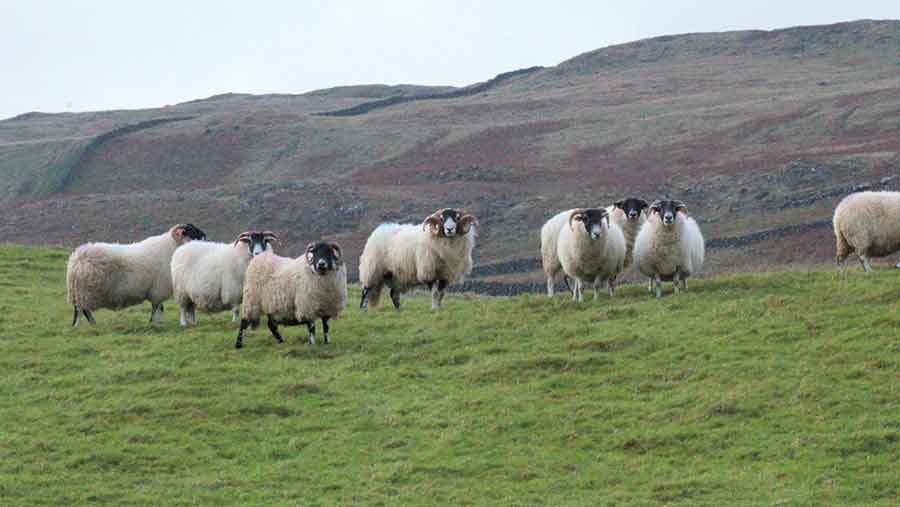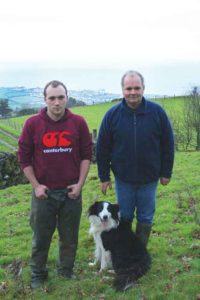Sheep – should I stay or should I go?
Tight sheep margins for a number of years are prompting some producers to re-evaluate their future in the sector. In the latest of our series we examine what to consider before making the important “stay or go” decision.
It has been a tough few years for all livestock sectors and despite a recent upturn in prices, sheep is no exception. Growth of the national flock to its current level of around 16 million, combined with relatively weak trade, strong global competition and stubbornly high costs, has squeezed margins.

Andersons estimates the 2016 cost of production for lowland and upland flocks is typically £1.90-£2.20/kg liveweight, which remains above the seasonal average price for many producers.
Markets fluctuate continuously though, as demonstrated by the weakening of sterling following the Brexit vote which improved fortunes for the crucial export market in particular.
See also: Revealed – supermarket commitment to British lamb
Volatility will remain whether the UK is in or out of Europe, and it will be down to the resilience of individual businesses to ride out the low points and capitalise on any improvement in domestic markets.
Evaluate performance
Producers have little control over market prices so the starting point for anyone considering whether to “stay or go” is to accurately assess physical flock performance, plus fixed and variable costs, says ADAS senior consultant Tony Turner.
“Keep an open mind, but remember you can only change things you have control over, which is generally the technical aspects of flock management.”
Knowing how your flock performs against others in terms of key performance indicators, such as scanning percentage or lambs reared per 100 ewes, and cost of production is vital to make an informed decision, he says.
The AHDB beef and lamb Stocktake service (http://beefandlamb.ahdb.org.uk/returns/stocktake/) is a good starting point for benchmarking performance and enterprise costs against the industry average and top or bottom performing producers. Quality Meat Scotland also offers a benchmarking service.
While costing analysis and benchmarking can highlight problem areas, Mr Turner says figures should not be used in isolation, especially where there are small datasets.
A good example of why it is important to consider more than one set of figures is the analysis of 2015 April/May lambing non-SDA flocks.
This shows a scanning percentage of 170% per ewe for the bottom third, but just 154% for the top third. It is the management from scanning onwards and better cost control that makes the difference, says Mr Turner.
In this case the bottom third made a negative full economic net margin of £46 a head, while the top third made £6.80.
“The difference between top and bottom producers is often down to fixed costs, one of the main ones being labour.”
He urges farmers to go through past accounts to see if equity is being eroded by an underperforming part of the business, as this is unsustainable in the long term.
“Work out whether there is a cash surplus or deficit after all costs, including loan repayments, depreciation and drawings. Having a constant cash deficit is a problem if borrowings are increasing or you’re eroding capital.”
Eroding capital (for example, by occasionally selling off parcels of land to prop up the business) may be less of a concern where nearing retirement and there is no successor, but it is not the answer where there are others looking to take the business on, he says.
Making changes
Once problem areas have been identified, the focus should be on identifying which aspects can be changed, what difference it will make and whether it will be enough to improve the bottom line, says Gavin Hill of Scotland’s Rural College.
He encourages farmers to “take a step back and keep an open mind” and consider views from other farmers and consultants during this process.
A fresh pair of eyes often brings new ideas that may have otherwise been overlooked, he says.
There is a range of farmer discussion groups across the UK, such as the QMS Grazing Groups, or AHDB/QMS Monitor Farms.
Cashflow benefit from selling sheep
A key consideration in the “stay or go” debate is the cashflow benefits to the farm business from regular sales of sheep at times when income from other sources (for example, crop sales) is limited, says Simon Draper, auctioneer at Thame Farmers Mart.
“Selling 20 fat lambs every week might bring in £1,400-£1,500, which can make quite a difference to cashflow. It’s a major reason why a lot of people keep a sheep flock on the farm.”
If the decision is made to leave the sheep sector, the main time to sell breeding stock is between August (early lambers) and September (March lambers), he notes.
Sales are very seasonal though, so it is worth following markets and not rushing any decision to get the best price.
Lifestyle
Although financial performance is important when deciding whether to continue, sheep farming is a way of life and the importance of lifestyle considerations should not be underestimated when contemplating future moves, says Mr Hill.
“It’s a big decision to make and everyone is different.” He advises farmers to weigh-up the main reasons for keeping sheep and identify the “end goal”.
For example, is it primarily a commercial business that must be profitable enough to support future generations or is it more of a lifestyle choice?
Succession planning is a key part of this process, adds Richard Miller, head of agribusiness at Burnetts solicitors, who says the views and ambitions of future generations must be taken into account.
In some cases there may be an opportunity to bring other family members into the business through a partnership agreement, potentially allowing one partner to stand back from daily management, but retain “active involvement” for lifestyle and tax reasons.
Examine the options
A range of options is available to change the course of a business and this does not necessarily mean selling up, as shown below:
- Change the system – more farmers are moving to extensive “easy-care” breeds and production systems to reduce labour requirements, feed and other costs (see box)
- Rent land to another farmer – only an option for owner-occupiers, but allows a continuation of the lifestyle and tax advantages of owning land. Opportunity to bring in new ideas
- Share/ contract farming – can spread costs and bring in new ideas/ enthusiasm. May also allow the day-to-day running to be handled by someone else, freeing up time to concentrate on other enterprises or a for a new venture, to cope with illness or allow retirement/semi-retirement
- Downsize – scaling down the sheep enterprise may free up time to diversify into other areas or to get a part-time job off the farm. Allows an alternative income stream, but maintains some of the lifestyle benefits.
- Diversify – individual site characteristics determine the options available, but consider what else could be done on land
- Sell-up – the last resort for many, but it may be best in the long term
- Maximise existing assets – consider whether you’re getting the most from assets such as labour, land, livestock, buildings, or machinery. Also check whether it is possible to get more out of stewardship schemes.
Legal and tax considerations
Agricultural land and property remains a tax-efficient use of capital (particularly for inheritance tax), which needs to be considered within the stay or go decision process, says Mr Miller.
Depending on individual circumstances and tax relief available, selling-up could incur capital gains tax and farmers should consider this and any other possible liabilities, such as the accounting tax bill from a sale of assets, before making any decision.
Early repayment charges on fixed-rate loans can be particularly significant, he notes.
Where a decision is made to leave a farm business tenancy agreement, Mr Miller says landlords may seek compensation or ask that the full rental term is seen out.
There could be an option to sub-let, but this is rare and there needs to be a discussion with the landlord as to the most appropriate route forward, he says.
Exploring the options
The biggest financial issue on many sheep units is the high fixed costs associated with conserving and storing feed, housing and feeding stock, says sheep specialist John Vipond, who advises farmers to consider all possible ways of reducing such costs.
A popular option is a move to all-grass wintering using the “easy-care” breeds. Moving to a hardier breed that is able to lamb outside significantly reduces fixed costs, he says.
“The average small flock lambing inside requires roughly one labour unit for every 150 ewes. For an easy-care outside system that could increase to one for every 600 ewes with wool or one to 1,500-2,000 for wool-shedding breeds.”
It may require an initial investment in fencing to improve grazing management and some form of emergency shelter in the event of bad weather, Dr Vipond notes. This need not be housing, but could be a wooded area, or sheltered field with good access for feeding.
He acknowledges such systems may not be possible where grass growth is not year-round, so a more flexible system involving temporary housing over winter may be more suitable. Selling lambs earlier at a lighter weight is another option to reduce feed costs, he notes.
Utilising grass and conserved forage more efficiently is also vital, as feeding high-quality silage can reduce concentrate costs and improve physical flock performance, says Wiltshire sheep farmer and Farm Consultancy Group member George Drewett.
Soil analysis will help identify possible deficiencies and maximise the growth and nutritional value of grass, he says.
Where sheep are part of a mixed farm, Mr Drewett advises farmers to consider their wider impact, which can be hard to quantify.
For example, grazing sheep may benefit the arable rotation by returning nutrients or controlling blackgrass; stock can utilise existing labour at quieter times and provide a regular income stream.
Other aspects such as blood sampling for trace element deficiencies and vaccination against diseases such as pasturella are worth considering to improve performance, he notes.
‘Stay’ case study: Partnership reinvigorates NI sheep farm
Two years ago Northern Ireland sheep farmer Samuel Wharry decided against giving up sheep production and instead entered a business partnership with an enthusiastic young farmer from Ballymena.

James Davison (left) and Samuel Wharry
The move has revitalised the 220ha hill farm in County Antrim.
Mr Wharry, who was appointed National Sheep Association chairman last January, hopes it serves as an example to others of how it is possible to help new entrants.
He maintains an active involvement in a profitable sheep enterprise, even with retirement looming.
The farm has historically maintained a purebred Scottish Blackface flock, but a move six years ago to a more extensive system based around an agri-environmental scheme saw numbers cut from 600 to around 375-400 head.
“I was 10 years off retirement with no children to take over the farm, so had to decide whether it was worth continuing to farm extensively with 350 sheep and claim payments or eat into the asset base to fund my retirement,” says Mr Wharry.
“With relatively few stock I wouldn’t have been able to justify investing in the business, so the farm would have gone downhill, which is not what I want.”
It was in 2014 that he discussed the possibility of forming a mutually beneficial business partnership with James Davison, a 23-year-old farmer who occasionally helped on the farm.
“James was very enthusiastic about sheep and keen to get involved but had little land of his own, so it seemed like a good opportunity for us both.”
Mr Wharry leases the land and buildings to the partnership for a nominal rent (to cover maintenance), while day-to-day flock management is done by the partnership, which pays both parties a monthly wage of £600 plus annual profit share.
The profit share split is flexible to reflect the effort of each member and this year is set to be 60:40 in Mr Davison’s favour due to him taking on more of the day-to-day running.
The initial aim is to run the partnership for five years, during which time Mr Davison is able to buy into a share of the stock, up to 50% of the total headage after five years. Payments are based on a valuation at the start of the agreement.
Mr Wharry says the partnership has reinvigorated the sheep enterprise and seen numbers increase as new initiatives have been implemented.
Some 700 ewes will be put to the tup this autumn, with numbers set to reach 800-900 over coming years.
The farm continues to run 380 April-lambing Scots blackface cross Swaledale ewes on the rougher moorland, but also has 320 Lleyn-cross ewes, which are kept in a new rotational grazing system on lower land closer to the farm.
“One of the biggest benefits of the partnership is seeing the farm appreciate as I near retirement, not depreciate. When cutting costs becomes asset stripping, you know it’s time to do something about it.”
Mr Wharry also values the new ideas being brought to the farm (such as rotational grazing) and being challenged about the way things have been done.
Cattle have also been reintroduced on to the farm, with a small herd of 50 dairy-cross heifer calves, which are bought-in and reared for beef.
“They help manage the grassland and should make some money this year, so it looks to be a good move.”
‘Go’ case study: Poor margins prompt big changes in Norfolk
Disillusioned with selling January- and February-born lambs at well below the cost of production, Norfolk sheep producer Andrew Foulds sold his 2,000 productive Suffolk Mule ewes and Mule ewes last August/ September.

Andrew Foulds © Jason Bye
Fat lambs at the time were about £20 a head below the cost of production, although he acknowledges that current prices, following the weakening of the pound, are more acceptable.
Production costs and output for the system were high, Mr Foulds explains. With lambing taking place in two bale yards rather than purpose-built sheds and a labour requirement of one shepherd to every 200 ewes, continuing with intensive lambing was unprofitable.
Fortunately there were job vacancies in the area and both the shepherds who left following the sale of the ewe flock went on to other employment. All the keep is on a seasonal basis, giving flexibility to run store lambs as trading conditions permit.
“We are still very much in the sheep job but with more flexibility and control over what we do,” says Mr Foulds.
